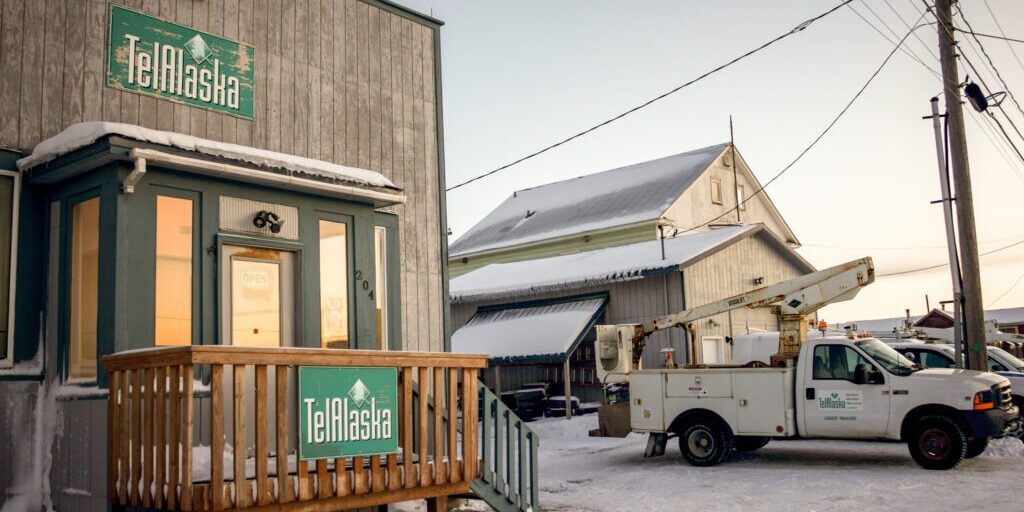Internet capabilities in Nome, like anywhere else in Alaska, have improved drastically over the years. Starting with systems like Nook Net, going through satellite providers and bigger companies such as GCI, to now having access to unlimited bandwidth capacity through Quintillion’s fiber optic project. KNOM’s Davis Hovey reports on how this new internet option in Nome both meets expectations and, for some, misses the mark.
TelAlaska announced last week (Dec. 3) it is offering high speed internet in Nome through an agreement with Quintillion, providing the first option for Nome residents to purchase internet services on fiber.
“And of course it’s a little pricy for some of us. It looks like other people are gung-ho to jump on, so I wish them well.”
Nome resident Jim Dory has been in town for the last 40 years, which is longer than the entire lifetime of the “world-wide web.” He says he has no plans to buy a package from TelAlaska, even though his current internet package through another provider in Nome is barely meeting his needs.
“I do a lot of research on boat building, since there isn’t a lot of resources in town for that. YouTubes, and how to do things, so we watch an occasional YouTube video or this and that. But the 60 GB (data cap) serves us well; we don’t watch t.v. (online), so we don’t have that demand.”
TelAlaska has several offerings for residents, all of which have data caps, starting at 170 GB for the cost of $179 a month. When asked how these packages were determined, TelAlaska’s marketing manager, Celine Kaplan, says the company felt offering unlimited bandwidth or no data caps was not necessary to meet Nome’s needs:
“We worked with Quintillion in putting these packages together, and we do feel that while we do still have usage caps, they are quite high and will meet customers’ needs. And in addition to that, the overage fees are much lower than we would typically charge (at TelAlaska).”
According to Kaplan, TelAlaska’s internet involves the local telephone service, so residents must also purchase a land line in order to use the connection to fiber. That means a line charge, more surcharges, and taxes totaling up to about $30 in addition to the monthly internet cost. And as Kaplan alluded to, TelAlaska charges $1 per GB for going over data caps.
Kaplan says she wasn’t involved in the final pricing for TelAlaska’s packages in Nome, but her understanding is that the prices were set based on how the company felt they could provide the service.
Kristina Woolston, VP of External Relations for Quintillion, couldn’t offer much insight into the breakdown of prices, either. She describes the new offerings as a “unique” agreement.
“So, we’re excited about the package offerings, up to triple and sometimes quadruple the speeds and double and butting up against triple the data (in Nome). And we feel it will have a meaningful and long-term impact on the community. And you see this over time, in any market, is that things evolve with offerings and the market evolves. This first offering is a substantial and meaningful improvement than any service that was available before (in Nome).”
It’s taken several years for the internet market in Nome to evolve to its current state. Originally, this high speed fiber network through Quintillion was scheduled to be in service by 2014, then pushed back to 2016, and then finally went live December of 2017. But even during that time a year ago, Quintillion only had plans with companies to offer commercial services to local entities like Kawerak and UAF Northwest campus.
After waiting months on top of years for residential internet services, citizens of Nome have an option to purchase high speed internet, yet it still has data caps instead of being unlimited. Michael “Mac” McHale, the new Chief Revenue Officer for Quintillion, says the difference between shared services and dedicated services complicated and lengthened negotiations with TelAlaska, which could have affected final decisions on data caps.
“You’ve got users who are going to use the service casually, and you’ve got other users who are going to use the service more intensely. It makes for much more complex service delivery, and that’s essentially it. So again, it’s point A to point B versus point A to 500 different points, and managing all those interactions and transactions.”
Owner of Trinity Sails and Repair (TSR), Rolland Trowbridge, said in a previous interview with KNOM that the way Quintillion negotiates with providers requires full subscriber money up front, which some people, like himself, don’t have. Trowbridge currently provides residential internet services in Nome with unlimited bandwidth capacity, but through satellite. According to Trowbridge, for Nome residents “the reality is that what you’re paying — in the $150 to $300 range for internet — probably isn’t going to change.”
Outside of TelAlaska, it would seem there won’t be other providers or options for Nome residents to purchase high speed internet through fiber, at least not in the near future.
Woolston and McHale say Quintillion is having “business discussions” about other possibilities for Nome but can’t discuss details until they are public. According to Kaplan, TelAlaska has no information about further projects or offerings outside of these fiber packages in Nome.
Retired engineering technician for the City of Nome, Jim Dory says he had hoped for a retailer to provide fiber internet to everyone’s house within Nome, either wired or wireless. Even though that is not the reality, Dory remains hopeful.
“There are systems down the road. I guess Elon Musk is putting up a satellite system that’s supposed to cover the Earth, you know, everywhere. So, you know, you can be hopeful, things will improve over time.”
Image at top: TelAlaska offices in Nome, December 2018. Photo: Davis Hovey, KNOM.




